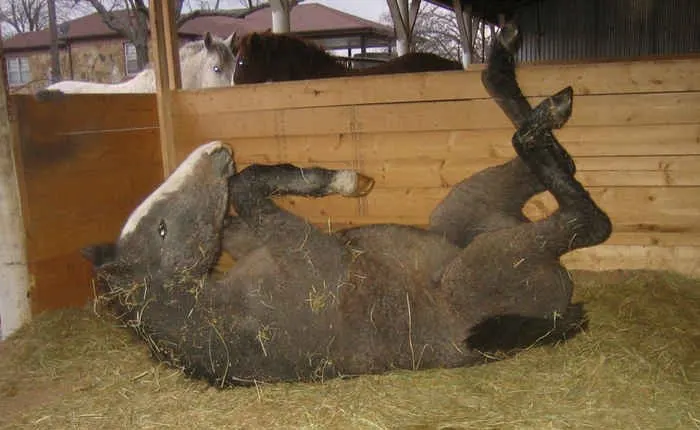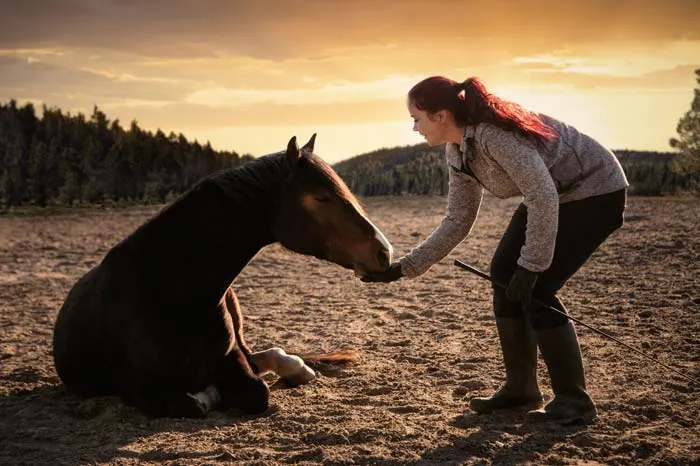Most people have never seen a horse roll over, so it’s not surprising that one of the questions I hear most often about horses – especially from kids – is whether horses can roll over. In fact, horses can roll over, and in this post, we will explore some norms about how often horses roll over, the mechanics of how a horse rolls over, things to be concerned about, and even how to train your horse to roll over on command!
Not all Horses can Roll over
For horses, rolling over is a little bit like doing a handstand or cartwheel for humans. In other words: most horses could roll completely over if they really really wanted to, very few do it naturally, and some aren’t capable of rolling over at all- while a select few individuals might roll over several times a day! Whether a horse can or cannot roll over depends a little bit on muscle tone but mostly on the horse’s conformation (aka, the way that their body is put together, its proportions, and build).

Whether a horse can or cannot roll over also depends on the ground the horse is laying down on. Some surfaces – especially soft ones- are easier to roll over on, while harder surfaces – even hard grass in a pasture or packed dirt – may make it impossible for a horse to roll onto its back past the point of where its withers extend from the top of their shoulders.
Most Horses will only Roll Halfway Over
The majority of horses, when they lay down to roll, will only roll about halfway onto their back and then return back to a laying position laying on the same side they started in.
It’s nothing to be worried about if your horse doesn’t roll all the way over onto its other side when it lays down to roll – this is normal horse behavior. A few horses may roll all the way over onto the other side frequently. These horses often have low withers and a build that makes it easier for their bodies to roll past the point the halfway point.
When you should be concerned
One thing you should notice and mention to your vet, however, is if your horse previously used to roll completely over on a regular basis and suddenly stops. Any significant change in a horse’s range of movement, such as this, could be a sign of an injury or spinal misalignment and should be mentioned to your veterinarian for appropriate health screenings.

Training a Horse to Roll Over as a Trick
Training a horse to rollover is a very, very difficult trick to train a horse – but that doesn’t mean it’s impossible.
Like training a horse to lay down, training a horse to roll over takes a lot of trust. But unlike training a horse to lay down, training a horse to roll over also takes a huge effort on the horse’s part – and a little bit of luck, since your horse’s conformation may not even make the trick physically possible. But if you have seen your horse roll completely over from one side to the other at liberty (that means when loose) it’s a good sign that your horse may be able to be trained to roll over on command.
To teach your horse to roll over on command you first need to do a safety check-in with yourself and how you will navigate training your horse to roll over. While horse training generally requires that you stand near your horse, this trick will involve flailing limbs that could easily injure you or a bystander. Be sure to maintain a safe distance at all times when your horse is off its feet- It may kick out or spring to its feet with only a split-second notice, and you should always be aware and out of the way.
To train your horse to roll over on command, you’ll start by teaching them to lay down on command. Using the same methods described in the article on how to train your horse to lay down, use the clicker to begin withholding reward until the horse begins to make movements from the laying down position rolling farther onto their back.
A horse extremely keen on clicker training – and this will take time invested and great skill and timing on the part of the handler- will learn to experiment with new behaviors in an attempt to get the desired reward and that powerful click.

Once your horse rolls back, reward your horse when they roll back from a regular laying down position onto their side and keep rewarding this behavior consistently. Slowly, withhold reward until the horse rolls onto their side plus a few more degrees of rotation. Gradually, by extending the required angle to get the click and reward, you can teach your horse to roll from a laying down position onto their side, from their side onto their back, and from their back onto the other side, completing a full – and extremely impressive- roll over.
I personally have never succeeded in training a trick training a horse to complete this trick due to its complexity and requirements for the horse to have the right confirmation for the track, but with clicker training it – and many other complex tricks are possible. Note that this trick should only be attempted by expert handlers. Incorrect timing or reward during click training may result in a reward-seeking horse laying down while carrying a rider or in other dangerous, not-trick-appropriate situations.
